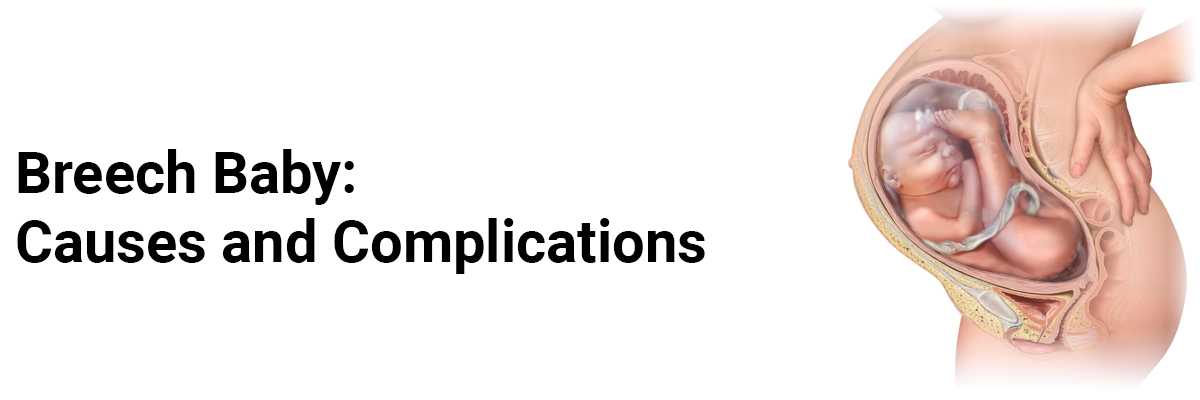
 Mrs. Mayuri Mathur
Mrs. Mayuri Mathur
Breech Baby: Causes and Complications
In a normal pregnancy, the baby is positioned in the womb with its head pointing towards the birth canal. However, in a breech pregnancy, the baby is positioned head-up, with its feet pointing towards the birth canal. This presents a challenging situation for both the mother and baby, as the baby is not in the ideal position for delivery. It can pose multiple risks during childbirth and may require special care and delivery techniques.
The types of breech presentations are-
• Complete: The fetus shows bent knees and the buttocks present (at the vagina during delivery) first.
• Frank: The fetus shows stretched legs upward toward the head, and the buttocks present first.
• Footling: The fetus shows its foot first.
• Transverse lie: The fetus is positioned horizontally across the uterus instead of vertically; thus, the shoulder presents first.
Symptoms of Breech Pregnancy
There are no clear signs or symptoms that the baby is breech, and usually, the position of the baby does not affect the pregnancy.
However, common symptoms of a breech pregnancy can include abdominal pain or pressure, feeling a lump in the area of the baby's bottom, decreased fetal movement, and pelvic tilt or pressure. The mother may notice that the baby kicks lower in the abdomen and feel a hard lump close to the ribs, which is the baby's head. In some cases, a woman may have vaginal bleeding.
Most babies born breech are generally healthy; however, they have a slightly increased risk of certain birth defects compared to babies, not breech. The baby's heartbeat may also sound different than normal due to the unusual position.
If any of these symptoms are present, medical attention should be sought immediately.
Risk Factors
Most breech presentations do not have any specific risk factor. However, certain settings can increase the risk of breech presentation, like-
• Previous pregnancies
• Multiple fetuses
• Abnormal shape of the uterus
• Uterine fibroids (noncancerous growths inside the uterus)
• Placenta previa (a condition in which the placenta rests upon the opening to the uterus)
• Preterm labor or premature fetus
• Altered quantity of amniotic fluid
• Fetal congenital abnormalities
Diagnosis
A healthcare provider can diagnose a breech pregnancy through a physical examination or an ultrasound. During the physical examination, the healthcare provider will feel the abdomen to determine the position of the fetus. An ultrasound is also used to confirm the diagnosis, as it can show the exact position of the fetus and its estimated size.
It is not beneficial to diagnose a breech presentation of the fetus before the last few weeks of gestation, as there is a high likelihood that the baby will have shifted to the correct vertex position by 35 weeks.
Treatment
Before delivery, the gynecologist may also attempt the external cephalic version (ECV) procedure to turn the fetus into the vertex position. This procedure involves propelling the pregnant person's belly to turn the fetus while monitoring the maneuvers on an ultrasound. ECV is usually done around 37 weeks gestation but may be uncomfortable for many.
ECV is usually not advised in cases with-
• multiple pregnancies
• wrongly placed placenta
• concerning fetal health
• specific abnormalities of the reproductive system in the mother
There may be some risks associated with ECV like-
• Premature labor.
• Premature rupture of the amniotic sac.
• Blood loss
• Emergency C-section.
• Risk of baby turning back to the breech position.
• Alterations in the fetus's heart rate
• Placenta tearing away from the uterine lining
Although there is minimal risk of these complications, some doctors prefer not to attempt an ECV. On the contrary, according to the American College of Obstetricians and Gynecologists (ACOG), ECV can be performed in a person with previous cesarean delivery. However, ECVs are successful only in about 50% of the cases.
Delivering a Breech Baby
Most fetuses with breech presentation are delivered by cesarean section or C-section. In rare instances, the gynecologist may plan a vaginal birth of a breech fetus. However, it carries more risk than cesarean delivery. The doctor weighs the risks and benefits of ECV, delivering a breech fetus vaginally, and cesarean delivery.
Vaginal Vs. Cesarean delivery in the breech position
The infant death and complications rates are reported to be markedly lower with planned caesareans for breech babies. However, cesarean surgery has its inherent complications for mothers. The British Journal of Obstetrics and Gynecology advises that if a mother wants a planned vaginal delivery with a breech pregnancy, she might still have a chance to maintain a safe delivery with a trained provider. However, most doctors prefer to take the safest route possible. Hence, a cesarean is the preferred delivery method for women with breech pregnancies.
Complications of breech delivery
Breech delivery may induce multiple risks to the baby. It can cause the delivery of the umbilical cord first, which may be squeezed by the exiting fetus. The condition is known as cord prolapse, which puts the fetus at risk for diminished oxygen and blood flow. Breech delivery also risks stucking the fetus's head or shoulders inside the mother's pelvis, leading to suffocation. Therefore, C-Section delivery is the preferable option for safe childbirth. However, cesarean delivery may carry complications like infection, bleeding, injury to other internal organs, and problems with future pregnancies.
The bottom line
Discovering the baby's breech position can be highly stressful and change one's vision of childbirth. Most fetuses turn to the normal position before the mother enters labor. Breech position before 36 weeks of pregnancy is not a concern as a fetus usually moves around in many different positions before that time.
However, if your fetus remains in a breech position at the end of the pregnancy, the gynecologist may perform maneuvers to turn the fetus around. The healthcare provider will also direct what to expect during a breech delivery. They can help understand the risks and benefits of a breech birth to keep both mother and the baby safe.

Mrs. Mayuri Mathur
Mrs. Mayuri Mathur is a Senior Medical Writer (Patient education and digital) and seasoned content creator with a rich tapestry of expertise spanning over ten years. With a diverse background in content creation, she brings a wealth of experience to the table, from crafting insightful medical articles to developing comprehensive patient education materials, dynamic press releases, and captivating brochures and website content. Throughout her illustrious career, she has demonstrated an exceptional knack for distilling complex medical concepts into easily understandable content, making her a trusted resource for both professionals and lay audiences alike. Her meticulous attention to detail and innate creativity have enabled her to deliver content that not only informs but also engages and inspires. Whether elucidating intricate medical procedures or crafting compelling marketing materials, her versatility and dedication shine through in every project she undertakes. Her passion for writing, coupled with her profound understanding, makes her an invaluable asset to any team or project. In a constantly evolving digital landscape, where effective communication is paramount, Mrs. Mayuri Mathur stands out as a beacon of excellence, consistently delivering top-notch content that resonates with audiences across diverse platforms.

.png)

.png)
.png)




Please login to comment on this article